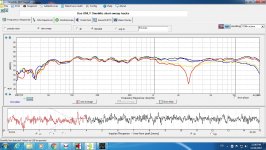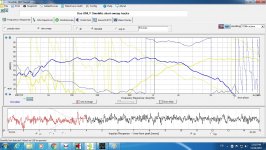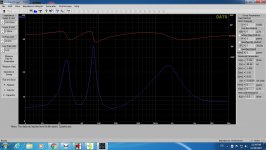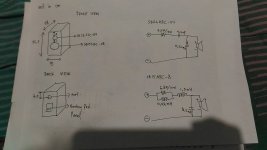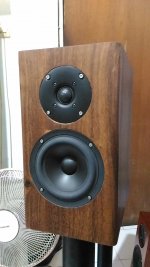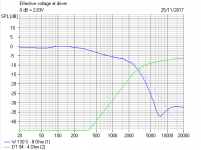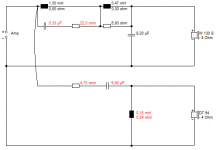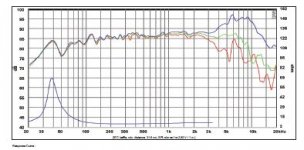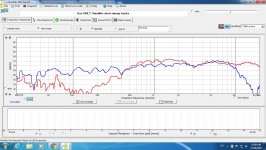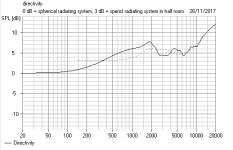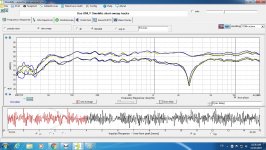Hi all,
Just want to share my speaker project, a small 2 way ported using 1x SB15MFC-08 midwoofer and 1x SB26STC-04 tweeter.
The box design is using 9-10 litres MDF 2.5 cm thickness, with dimension 19x35.5x28 cm (WxHxD), port dimension is 4.3 cm inner diameter and 17 cm effective length giving a box tuning of 45 Hz (you can adjust this to higher fb, around 50Hz, to get a better midbass definition by adjusting the port length). I do flare the two side of the port. Damping using 1 cm felt inside the box except the front side panel, you can add a little wool or anything else by experiment. Simple square bracing between tweeter and woofer, chamfering the woofer inner cut to give woofer a better airflow.
The crossover is using 2nd order electrical and acoustic with acoustic crossing point around 2.5Khz. The phasing is not good, but the frequency response is still within +/- 3dB as you can see at the attachment. Measurement done with microphone on axis to tweeter with a 25 cm distance, since my room is not good for measurement. To give you some idea about the off axis peformance, i measure it around 20-30 degree off axis response (black = normal on axis, red = tweeter polarity reversed, yellow = 20 degree vertical off axis, blue = 20 degree horizontal off axis). I use series resistor to level the tweeter and woofer. Baffle step compensation circuit is used to compensate around 2dB.
Speaker impedance you can see as attachment. Speaker placement can be tried to some 50 cm from the wall. The speaker attend Indonesia Loudspeaker Design Contest (IDLDC) 2017, but got lost there. So, here i share them.
Regards,
Roy
Just want to share my speaker project, a small 2 way ported using 1x SB15MFC-08 midwoofer and 1x SB26STC-04 tweeter.
The box design is using 9-10 litres MDF 2.5 cm thickness, with dimension 19x35.5x28 cm (WxHxD), port dimension is 4.3 cm inner diameter and 17 cm effective length giving a box tuning of 45 Hz (you can adjust this to higher fb, around 50Hz, to get a better midbass definition by adjusting the port length). I do flare the two side of the port. Damping using 1 cm felt inside the box except the front side panel, you can add a little wool or anything else by experiment. Simple square bracing between tweeter and woofer, chamfering the woofer inner cut to give woofer a better airflow.
The crossover is using 2nd order electrical and acoustic with acoustic crossing point around 2.5Khz. The phasing is not good, but the frequency response is still within +/- 3dB as you can see at the attachment. Measurement done with microphone on axis to tweeter with a 25 cm distance, since my room is not good for measurement. To give you some idea about the off axis peformance, i measure it around 20-30 degree off axis response (black = normal on axis, red = tweeter polarity reversed, yellow = 20 degree vertical off axis, blue = 20 degree horizontal off axis). I use series resistor to level the tweeter and woofer. Baffle step compensation circuit is used to compensate around 2dB.
Speaker impedance you can see as attachment. Speaker placement can be tried to some 50 cm from the wall. The speaker attend Indonesia Loudspeaker Design Contest (IDLDC) 2017, but got lost there. So, here i share them.
Regards,
Roy
Attachments
Last edited:
If you are curious about phase shift and time alignment, you can always experiment with a BW3 circuit on the tweeter for a more rapid phase shift around the crossover frequency.The crossover is using 2nd order electrical and acoustic with acoustic crossing point around 2.5Khz. The phasing is not good, ...Roy
If you are curious about phase shift and time alignment, you can always experiment with a BW3 circuit on the tweeter for a more rapid phase shift around the crossover frequency.
In your experience, how significant in/minimum phase allignment to sound quality? Any guide how much in/minimum phase should around xo (one octave?) to get a decent result? Is phase distance related?
I think the phase alignment is very nice, more concerned about the overall tilt. I'm worried it sounds pretty lean. What do you think in real life?
Best,
E
The graph give you some idea about the sound already, yes its sound towards lean, but you can make a little adjustment by toeing out it for speaker placement, reducing a little bump at top octave. Adding some tube preamp can add another harmonic distortion, maybe, to compensate the wide 'valley' on the 200-500hz region. But i do believe that the port tuning might too low.
You get what you get with filters, IMO. It depends on the drive units how nicely everything plays together. 5" bass plus 1" tweeter is a whole heap of fun, IMO.
I was surprised how much bass you can get out of a 5" in 10-15L of reflex. 5L closed box is a bit too constrained IMO.
Congratulations on a very nice project, Roy. And thanks for sharing. Most of us didn't know what to do with these beautiful low-inductance SB Acoustics drivers when they first came out. But the dust has settled a bit now.
SB Acoustics SB15MFC30-8 5" Poly Cone Woofer
I just played with your filter, and there is a lot to like there. I just wondered if the cone-breakup at around 6kHz is annoying? I might try a little 7kHz notch on the bass since it is cheap entertainment. Your tweeter filter is actually more of a 8 ohm design. The simple conversion to a 4 ohm type gets a better impedance without affecting anything else. We can regard tweeter level as adjust to taste.
Because I am as lazy as the next person, I'd just add the (cheap) 7kHz notch and see if it sounds cleaner. There is some substantial breakup there. It must be audible. I would think a 3W wirewound 22R and a 250V MKP 0.33uF would be adequate. Not much power up at that end.
I was surprised how much bass you can get out of a 5" in 10-15L of reflex. 5L closed box is a bit too constrained IMO.
Congratulations on a very nice project, Roy. And thanks for sharing. Most of us didn't know what to do with these beautiful low-inductance SB Acoustics drivers when they first came out. But the dust has settled a bit now.
SB Acoustics SB15MFC30-8 5" Poly Cone Woofer
I just played with your filter, and there is a lot to like there. I just wondered if the cone-breakup at around 6kHz is annoying? I might try a little 7kHz notch on the bass since it is cheap entertainment. Your tweeter filter is actually more of a 8 ohm design. The simple conversion to a 4 ohm type gets a better impedance without affecting anything else. We can regard tweeter level as adjust to taste.
Because I am as lazy as the next person, I'd just add the (cheap) 7kHz notch and see if it sounds cleaner. There is some substantial breakup there. It must be audible. I would think a 3W wirewound 22R and a 250V MKP 0.33uF would be adequate. Not much power up at that end.
Attachments
Sutantoroy, I think your tweeter level is maybe 1-2 dB too high. Also, lots of people like to add a little bump in the bass, or even tilt it all downwards a little. Try those ideas out.
Best,
E
Yes, i heard about it, but gambling to make 'revealing wannabe speaker' by letting the top octave a bit high, but you got the point about the the sound pattern, i mean some people do like those sound pattern.
It sounds like there's not too much stuffing In the boxes, so that shouldn't be killing the lows.
Can you shorten the port?
I want mostly to experiment to short the port, unfortunately it will not be a simple work aesthetically as the port already merges with the box (glued permanently).
You get what you get with filters, IMO. It depends on the drive units how nicely everything plays together. 5" bass plus 1" tweeter is a whole heap of fun, IMO.
I was surprised how much bass you can get out of a 5" in 10-15L of reflex. 5L closed box is a bit too constrained IMO.
Congratulations on a very nice project, Roy. And thanks for sharing. Most of us didn't know what to do with these beautiful low-inductance SB Acoustics drivers when they first came out. But the dust has settled a bit now.
SB Acoustics SB15MFC30-8 5" Poly Cone Woofer
I just played with your filter, and there is a lot to like there. I just wondered if the cone-breakup at around 6kHz is annoying? I might try a little 7kHz notch on the bass since it is cheap entertainment. Your tweeter filter is actually more of a 8 ohm design. The simple conversion to a 4 ohm type gets a better impedance without affecting anything else. We can regard tweeter level as adjust to taste.
Because I am as lazy as the next person, I'd just add the (cheap) 7kHz notch and see if it sounds cleaner. There is some substantial breakup there. It must be audible. I would think a 3W wirewound 22R and a 250V MKP 0.33uF would be adequate. Not much power up at that end.
I forgot, how i adjust the crossover components, but after adjusting the initial component value with the simulation, i also adjusting filter component value by measurement, so the filter might changed from the initial 4 ohm impedance filter. I attach the raw measurement both driver mounted in my current box. Both tweeter and woofer do share the problem at 5-6Khz bumping, but since the tweeter is more frequency dominant in that area, so i believe the tweeter is the more causant of that bump. Maybe ill try your idea for the notch filter.
One contestant of the IDLDC 2017 competition did the work normalize the speaker response anomalies, but then ended with the judge saying that he like the way that contestant compensating the anomalies, but it show lacks of dynamic, altough the frequency response is flat. I do quick measurement at that speaker few days ago, its response is really a flat one. The judge is mixing and mastering engineer, i amazed that he can hear the technical by ears.
Attachments
Just quoting because we are turning the page...Yes, i heard about it, but gambling to make 'revealing wannabe speaker' by letting the top octave a bit high, but you got the point about the the sound pattern, i mean some people do like those sound pattern.
I want mostly to experiment to short the port, unfortunately it will not be a simple work aesthetically as the port already merges with the box (glued permanently).
I forgot, how i adjust the crossover components, but after adjusting the initial component value with the simulation, i also adjusting filter component value by measurement, so the filter might changed from the initial 4 ohm impedance filter. I attach the raw measurement both driver mounted in my current box. Both tweeter and woofer do share the problem at 5-6Khz bumping, but since the tweeter is more frequency dominant in that area, so i believe the tweeter is the more causant of that bump. Maybe ill try your idea for the notch filter.
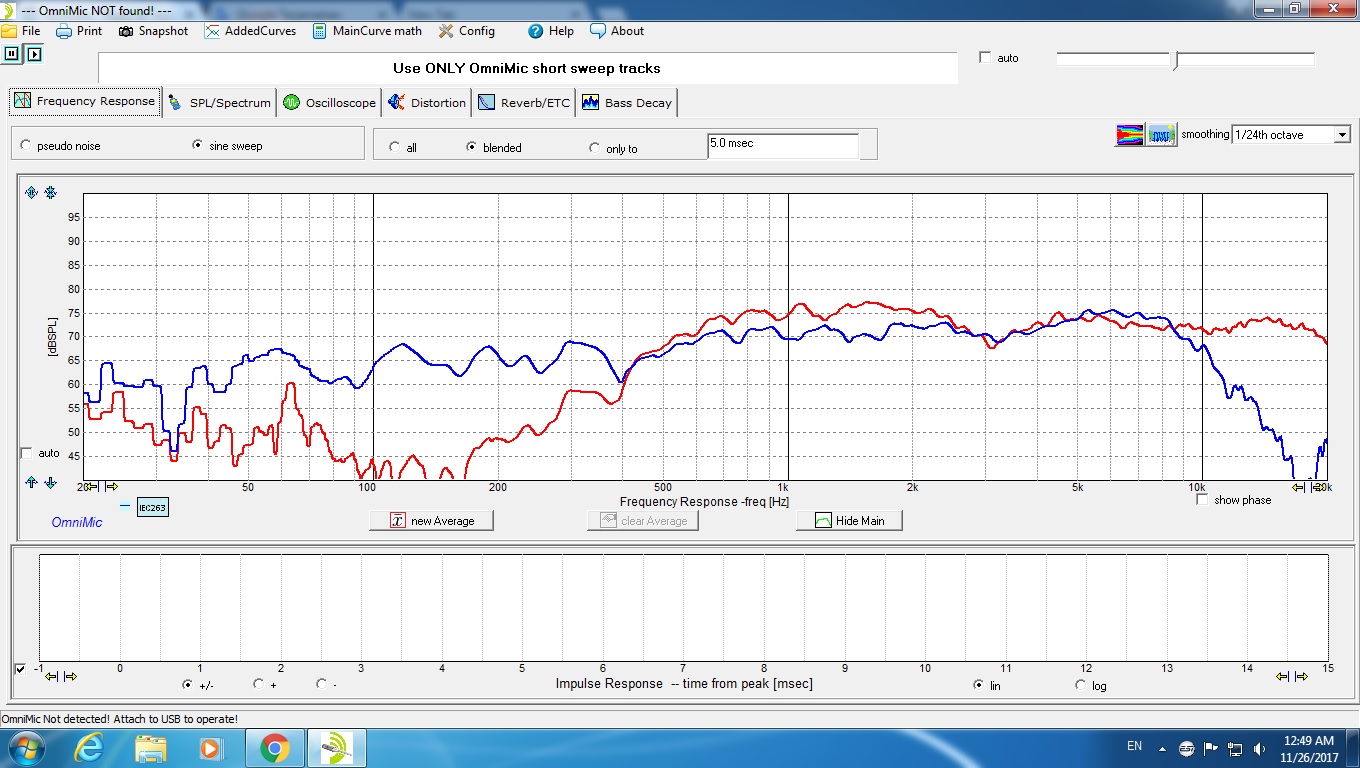
One contestant of the IDLDC 2017 competition did the work normalize the speaker response anomalies, but then ended with the judge saying that he like the way that contestant compensating the anomalies, but it show lacks of dynamic, altough the frequency response is flat. I do quick measurement at that speaker few days ago, its response is really a flat one. The judge is mixing and mastering engineer, i amazed that he can hear the technical by ears.
The other more equalised speaker was likely a higher order 4th order filter like LR4. Which always sounds different.
I suspect your response anomolies in the cabinet are diffraction effects. My rough sim with directivity shows mostly the same pattern of 2kHz peak and 3kHz dip. Dotted being flat baffle.
Attachments
Just quoting because we are turning the page...
The other more equalised speaker was likely a higher order 4th order filter like LR4. Which always sounds different.
I suspect your response anomolies in the cabinet are diffraction effects. My rough sim with directivity shows mostly the same pattern of 2kHz peak and 3kHz dip. Dotted being flat baffle.
Havent confirm about box and baffle diffraction, but some simulation do have these box and baffle simulation variable, we can take them as consideration. Try difference resistor value, it can adjust the level of top octave. Not a big difference in the sound signature but its quite significant. (Blue: 4.7R, Yellow: 5.6R, Black: 6.8R)
Attachments
Last edited:
Sutantoroy did a nice job on this speaker (haven't heard it of course). I was looking at that same poly cone woofer and this might be a nice design to use it with. I assume if there were phase issues around the crossover it would show up as off axis bumps but that doesn't seem to be the case.
It seems like a lot of attention is payed to the on axis response, but this doesn't guarantee good sound. With all the variables that enter in to it, it would seem like a good idea to build the speaker first without a crossover. Then hook it up to a PC with an active crossover or simulator and then just listen for a few months to what's going on with different crossover simulations, then take measurements. Equalizer APO can do this, even the impedance changes. You could also do it passively if you have a good collection of parts.
It seems like a lot of attention is payed to the on axis response, but this doesn't guarantee good sound. With all the variables that enter in to it, it would seem like a good idea to build the speaker first without a crossover. Then hook it up to a PC with an active crossover or simulator and then just listen for a few months to what's going on with different crossover simulations, then take measurements. Equalizer APO can do this, even the impedance changes. You could also do it passively if you have a good collection of parts.
Sutantoroy did a nice job on this speaker (haven't heard it of course). I was looking at that same poly cone woofer and this might be a nice design to use it with. I assume if there were phase issues around the crossover it would show up as off axis bumps but that doesn't seem to be the case.
It seems like a lot of attention is payed to the on axis response, but this doesn't guarantee good sound. With all the variables that enter in to it, it would seem like a good idea to build the speaker first without a crossover. Then hook it up to a PC with an active crossover or simulator and then just listen for a few months to what's going on with different crossover simulations, then take measurements. Equalizer APO can do this, even the impedance changes. You could also do it passively if you have a good collection of parts.
Thank you 33Polkhigh, actually its not good enough design, its port will start chuffing with more than 30 watts power input, i suggest use bigger box volume (12-15lts) and ports diameter. Yes its a good point to check the power response. Tonal balance would be a subjective preference taste, but to me, i prefer to design at tweeter on axis flat response, you can adjust your tonal balance later with toe in or out. I change the tweeter into SB25ADC, its a better tweeter to me.
I can't tell what the final cross-over is for these drivers, any one know?
I don't need BSC circuit, but doesn't hurt, I guess.
I use a lot of EQ anyway.
I don't like a lot of high frequencies, I usually EQ those out of every speaker I've ever had and raise the bass.
Also I have this tweeter:
SB Acoustics SB26STAC-C000-4
Same woofer:
SB Acoustics SB15MFC30-8
Wanted drivers with excellent build quality and grills, but I guess if you want both you have to buy Accuton, so I have the SB Acoustics.
I don't need BSC circuit, but doesn't hurt, I guess.
I use a lot of EQ anyway.
I don't like a lot of high frequencies, I usually EQ those out of every speaker I've ever had and raise the bass.
Also I have this tweeter:
SB Acoustics SB26STAC-C000-4
Same woofer:
SB Acoustics SB15MFC30-8
Wanted drivers with excellent build quality and grills, but I guess if you want both you have to buy Accuton, so I have the SB Acoustics.
I can't tell what the final cross-over is for these drivers, any one know?
I can't tell what the final cross-over is for these drivers, any one know?
The crossover is in the first post, Jimmy.
I had to remind myself why I changed the 4.7R/4.7uF/0.22mH tweeter crossover. Just a standard conversion for a 4 ohm tweeter. Impedance is probably flatter. The 0.33uF/22R notch is experimental, but usually aligns phase better.
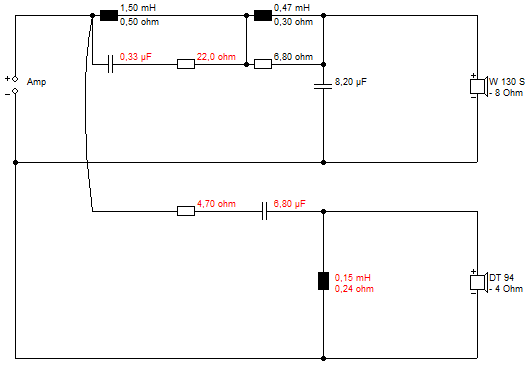
In the original crossover, you could certainly try adding a 15uF capacitor after the 0.22mH coil for third order. Just adds a bit of energy at crossover.
I had to remind myself why I changed the 4.7R/4.7uF/0.22mH tweeter crossover. Just a standard conversion for a 4 ohm tweeter. Impedance is probably flatter. The 0.33uF/22R notch is experimental, but usually aligns phase better.
In the original crossover, you could certainly try adding a 15uF capacitor after the 0.22mH coil for third order. Just adds a bit of energy at crossover.
Is this a joke?
Anyway, taking your point....
"I use a lot of EQ anyway. I don't like a lot of high frequencies, I usually EQ those out of every speaker I've ever had and raise the bass."
You could easily use the original circuit at the start of the thread.
increasing the woofer 1.5mH in stages would be an easy tune. tweeter level, maybe change the 4.7 to 5.6 or 6.8 ohms but as you equalise is these frequencies, why go that trouble?
You tweeter shouldn't be an issue.
Anyway, taking your point....
"I use a lot of EQ anyway. I don't like a lot of high frequencies, I usually EQ those out of every speaker I've ever had and raise the bass."
You could easily use the original circuit at the start of the thread.
increasing the woofer 1.5mH in stages would be an easy tune. tweeter level, maybe change the 4.7 to 5.6 or 6.8 ohms but as you equalise is these frequencies, why go that trouble?
You tweeter shouldn't be an issue.
My main concern, Raymond was that I wasn't talking complete rubbish in this thread.
Seems I was in top form!
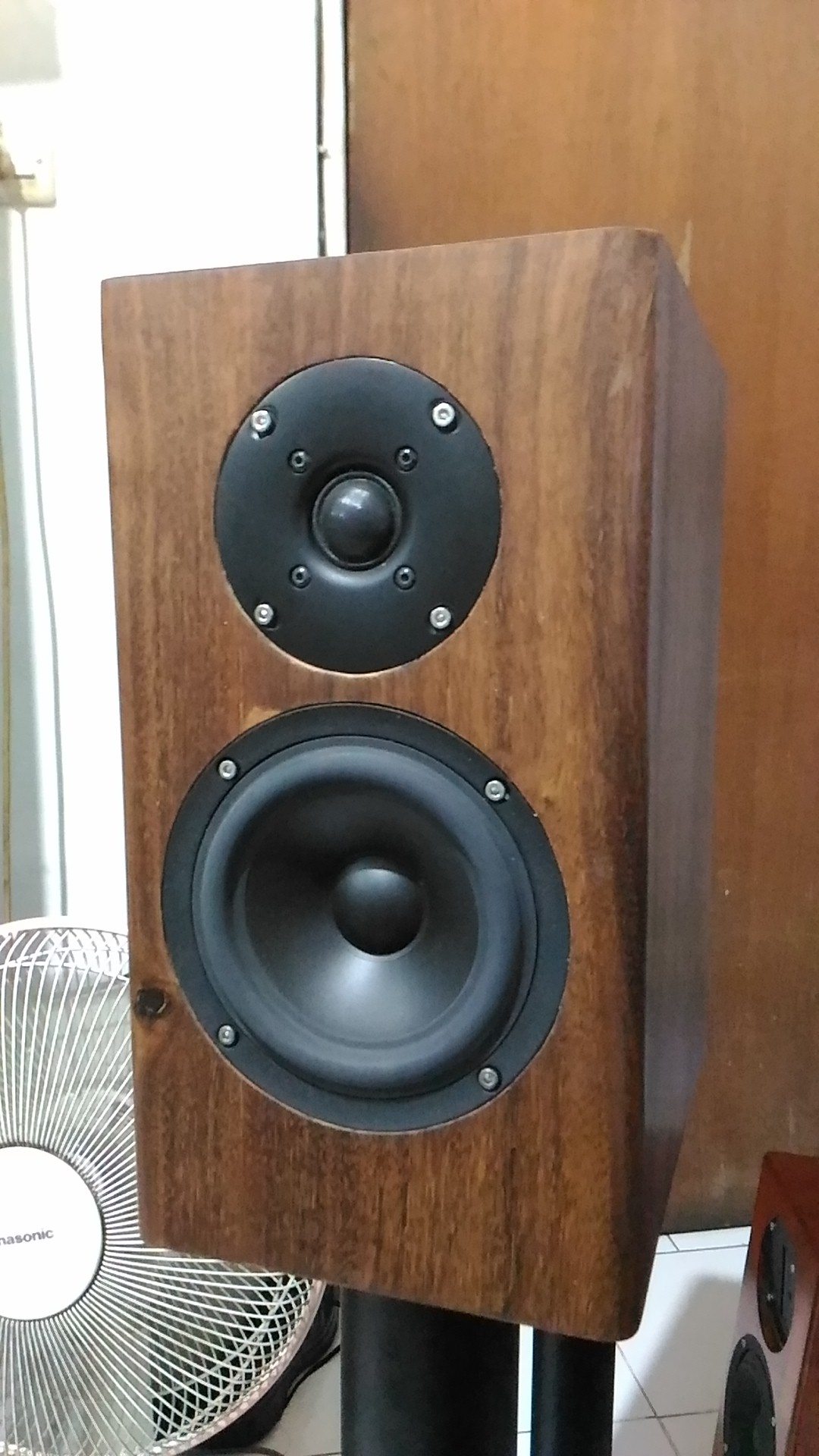
This is a 5" 8 ohm polycone with a 4 ohm 1" textile tweeter. IIRC, most people think SB's metal dome is better. But I don't know.
But a pleasant reflex speaker for a small room IMO.
Seems I was in top form!
This is a 5" 8 ohm polycone with a 4 ohm 1" textile tweeter. IIRC, most people think SB's metal dome is better. But I don't know.
But a pleasant reflex speaker for a small room IMO.
- Home
- Loudspeakers
- Multi-Way
- 2 Way SB15MFC-08 + SB26STC-04
